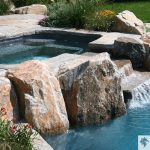The Best Swimming Pool Interior Surface Finishes
This summer has been a hot one, and there is no better way to find shelter from the heat than by jumping in the pool. But what if you have been thinking of redoing your pool’s interior? Then look no further. In this article, we will explore the best swimming pool interior surface finishes. When deciding to embark on such a project, it is important to get all the information you can. Not only can the process be expensive, but there are many varied materials you can use – some more sustainable and dedicated to longevity than others.
The most common finishes for a concrete pool are plaster, aggregate, and tile. Here is what you need to know about each type of interior pool finish.
Plaster Finish
Plaster is one of the oldest and most frequently used forms of pool surface finishes. Plaster is made from a simple mixture of water, Portland cement, and silica sand. There are a few advantages to using a plaster finish. This approach is inexpensive compared to other finishes such as glass or porcelain. Plaster also gives your pool a simple, classy look, and you can mix dyes to add dimension and a more dramatic effect. This finish can last for around 7 to 10 years before chipping starts.
But despite its clear benefits, a plaster finish can yield some unwanted outcomes. For example, if the plaster is a gray color, there is a potential for noticeable staining. Moreover, you must pay particular attention to the pH level of your pool’s water if you plan to get years of use out of it.
Aggregate
For an aesthetic upgrade, the aggregate approach might be a suitable decision – though there are a few different options, such as marble, quartz, pebble, and glass. Aggregate is a mixture of sand and pebbles and can either be sanded to create a smooth, untextured look or left exposed, which produces a bumpy texture.
There are benefits to using aggregate, such as its longevity when compared to plaster. Quartz can last anywhere from 7-12 years and pebble can last around 10 to 20.
While lasting quite a long time, an aggregate finish has its own set of issues. For one thing, larger pebbles can be uncomfortable to walk on. In addition, this type of finish is oftentimes more expensive than plaster, and can harbor calcium buildup. Calcium buildup is often hard to miss. You will be able to clearly see a white or gray stain in the pool. The result of calcium buildup is not pretty, it can give you itchy skin and burning eyes.
Tile
Tile finishes can be a beautiful addition to any pool. There are a few different materials you can use, such as glass, porcelain, or stone. Porcelain is the cheapest option, and it can be used to create glazed or textured patterns. Stones such as limestone and granite can create a soft, neutral aesthetic that works well for many pools. Glass – undoubtedly the most expensive option – is non-permeable (water resistant), low maintenance, and quite frankly, looks incredible.
Tile pool finishes certainly have their set of pitfalls. Tile, regardless of the material, is more expensive than aggregate or plaster by at least $4 to $30 per square foot. The tile can also chip, and, if installed incorrectly, can have sharp edges.
Choosing an Interior Pool Finish
The best interior finish for your pool is a decision that cannot be made in haste. The amount of money you are willing to spend is something to seriously consider, as well as the upkeep and maintenance of each material.
Here at Shoreline Pools, we can help you with any questions you may have regarding your pool’s interior finish. Call (203) 357-1544 to schedule an appointment today! Make sure to browse our project gallery to see our pool design capabilities.





